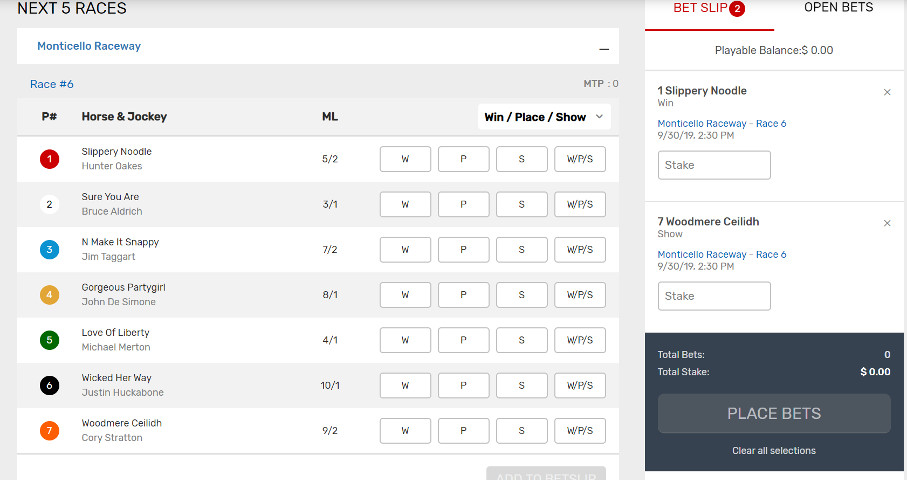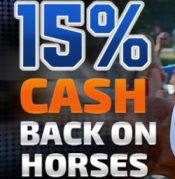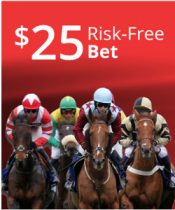Horse Racecourses 101: What to Know About Racecourses When Betting
When you are betting on horse races, many factors should go into your handicapping efforts. You’ll need to consider the horse’s condition, recent performance, and health. You will need to learn about the jockey and the trainer. But you must also take the racecourse itself into consideration before placing your wagers.
First things first, I’m going to tell you just a little bit about the best places to place your real money wagers on the horse action! Just click on any of these name to be taken to their respective review page!
Bovada
This is probably my favorite place to place my personal wagers. US friendly, solidly built site, used for years myself with no problems to speak of at all!
As you can see from the image above, the betting action is very clear and concise for you over at Bovada. In this example I chose Slippery Noodle to win and Woodmere Ceilidh to show. After that, I would go to the little box on the right, enter in my stake amount and then click “PLACE BETS” and then I’d be good to go!
Usually, the main welcome bonus for Bovada sportsbook is a Match Bonus for up to $250. Right now, as this is being typed, you can boost this up to a match for up to $1000 if you use one of the following codes when making your initial deposit!
- BVNFL1000
- BVNCAAF1000
Use bitcoin? You can also take advantage of up to $4500 in welcome money!
GTBets
GTBets absolutely nails it when it comes to the horse lovers.
Not all, but most Online Sportsbooks have no problem offering a 7% or a 8% rebate on horse racing losses. GTBets ups this by offering an incredible 15% monthly rebate on your losses!
If you happen to get bored waiting for the results of the latest race to come in, you can also check out their casino section where you will find not only the expected table games, but also a myriad of slots that are not available at most other sites.
BetOnline
BetOnline offers you a 7% rebate on the horse losses. They want to give you their own tips on handicapping the races, but this is perhaps the most important thing for the horse racing…
You can try it out totally risk free for (up to) $25!
Just join up and place your first real money wager with them. If you win, congrats, you’re already on a roll and ready to go!
Lose and you will be eligible for a total refund and get your money back! You’ll want to read the T’s and C’s and email them for your refund, but what have you got to lose? Nothing!
Now, you wanna learn about the tracks? Let’s get on with it!
To help take the races effectively, I’ve put together a comprehensive guide to horse racecourses. Let’s go over the different features of the racecourse which can impact the outcome.
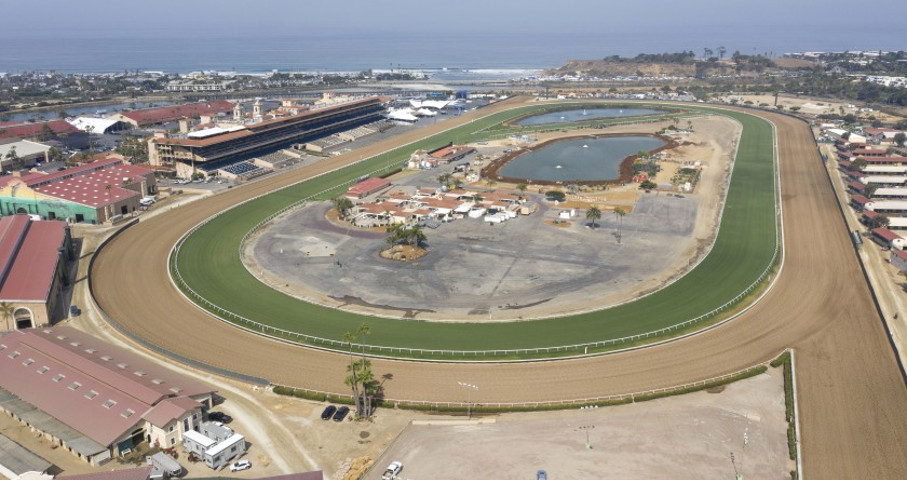
The Del Mar racetrack, located in Del Mar, California. It’s oval shaped, but a track does not have to be!
Length of Horse Racecourses
Technically, it is the distance of the race rather than length of the track which is most important, but the measurements for the track itself are also worth noting.
When you see the distance for a given race, either miles or furlongs will be used for measurement. If the race is at least one mile long, miles will be the units used. But if the race is going to take place over less than a mile of distance, you will probably see it quoted in furlongs instead.
So, what is a furlong, anyway?
A furlong is an eight of a mile.
A one-mile race takes place across 8 furlongs. A 2-mile race takes place across 16 furlongs. A half-mile race takes place across 4 furlongs, and so forth.
Some horses do better with sprints, while others may shine in longer distance runs. As I mentioned before, you should also pay attention to the length of the track itself.
When you look up statistics for a given racecourse, one of the numbers you will see is the measurement for that track’s “straight”. If there is a straight course as part of a racetrack, this statistic tells you how long it is.
This information is valuable for a couple of reasons. First of all, horses can pick up more speed on a longer straight. Secondly, some horses do better on tracks which have longer straights, and may not handle curves as well as others.
The Shape of Horse Racecourses
Almost all racecourses are oval shaped, but this is not a rule. You may find some tracks that have some variations in shape (figure-8 tracks, for instance, or even tracks which have a pair or triangle shape). Take note of these before you make assumptions about how each horse will perform at an upcoming event.
Direction
In the United States and in many countries throughout Europe, most courses run counterclockwise. But in some countries, horse races may run clockwise, for example, in Germany.
A clockwise race may also be referred to as a “right-handed” race. Likewise, a counter-clockwise race may be referred to as a “left-handed” race.
These terms can also used to reference specific tracks, as those tracks may only be used for clockwise or counterclockwise races. If a race takes place on a figure-8 shaped course, then one loop will be clockwise, while the other loop will be counterclockwise.
As you might expect, if a horse is used to going counterclockwise almost exclusively, and suddenly needs to race on a clockwise course, that could throw off its performance.
A jockey who is used to racing in a different direction than usual may find difficulty. Both the instinct to steer in the opposite direction and difficulties managing the horse could reduce performance for him as well.
Material
Horse racing tracks can consist of different surface materials as well. In Europe, horses usually race on grass turf. In the United States, however, they generally run on dirt. The material of the track will impact how it responds to weather and wear.
Surface Condition of Horse Racecourses
You will find the conditions of a racetrack summarized with the following terms.
- Fast
- Wet Fast
- Good
- Muddy
- Sloppy
- Slow
- Off Track
This is a dry, even track which provides for an ideal racing experience.
This is a fast track with a bit of moisture on the surface, as might occur if you had some drizzle or light rain. It is in most respects still identical to a regular fast track, but the damp top can alter how it runs.
This track is wet, but does not qualify as muddy (see below). If you are unfamiliar with horse racing track condition terms, you might easily mix this up with a fast track.
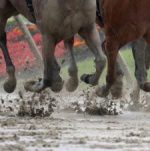
A muddy track. Some horses will excel here, others, not so much!
This is a stage of saturation past muddy where actual pools of water have formed.
The slow track. This is even more soaked than a sloppy one.
All of these conditions could mean that the track is wet fast, good, muddy, sloppy or slow. For example, the track has gotten wet, but just how wet is unknown. The phrase never refers to a fast track which is completely dry.
Dirt tracks are harder in general than turf tracks. Here are a few useful things to know about track conditions and different track materials:
If a horse excels racing on sloppy dirt, that same horse transferred to a turf track may also race effectively. Likewise, a horse which is used to turf may perform well on sloppy dirt.
Sloppy tracks require horses to run through puddles. When they do, they splash mud. This mud can be a bother both for jockeys and horses. Those which do not usually have to contend with mud may perform poorly.
It is possible that the race might be delayed due to track conditions. But it is also possible that it might simply be moved to a dirt track instead which is in a more favorable condition. Horses which might have done well before might not do as well on the dirt track, and vice versa.
Changes from turf to dirt can be last-minute in nature. If you’re waiting to place your wagers until shortly before a race, double check the weather, track conditions, and plans for the upcoming event.
You would not want to make an assumption that the horses will be racing on turf, only to find that they will actually be racing on dirt. The different track material could completely change the way that you need to bet.
There is something else which is also helpful to know about track materials and horse racing which has more to do with the status of the horse and the status of the track.
What if a horse has an injury? Imagine that the horse has just come back to racing. There is a good chance it will only scheduled to run in races on grass, not dirt. The reason for this is because the turf is less jarring. It is less stressful, and less likely to slow down recovery than runs on harder dirt tracks.
So, when you see that same horse returning to running on dirt tracks, you may be able to assume that the horse is largely recovered.
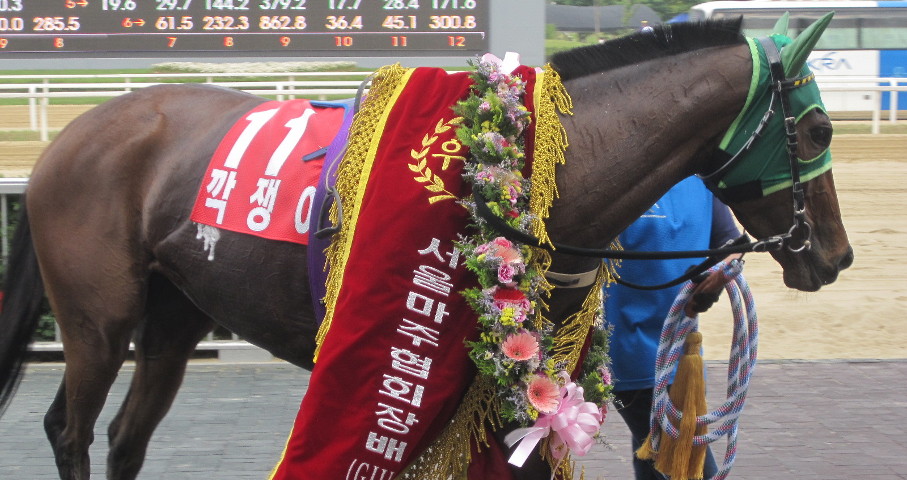
This is Kkakjaengi.
She won the Segye Ilbo Cup in Korea. Who knew they were into horse racing?
Speed/Difficulty
Does the length and shape of a course favor fast or slow runners? How agile do horses need to be to compete? The “speed” of a racecourse, also known as its “difficulty,” will tell you. Let’s go over some commonly-used terms which tell you what a course is like.
- Galloping
- Tight
- Sharp
- Stiff Fences
- Stiff
The difficulty level of this track is low. The turns are wide, so horses do not need to slow down as much as they might on some others. Horses can take this type of track at a gallop.
A “tight” speed implies the presence of tight turns. Horses must slow down for these turns.
This is another term used to imply the presence of tight turns which require horses to slow down.
If a track has fences which pose challenges either because of their dimensions or because of the slope of the ground, the situation is summarized in the phrase “stiff fences.”
A track which is referred to as “stiff” features an elevation change. There is an uphill section that can be taxing to run.
It is easy to see how this information could be valuable to you when you are planning your wagers.
If a horse which is not in peak condition is running a stiff track, for instance, you can expect the elevation change to fatigue that horse more rapidly than a competitor which is more ideally on form.
Should a particularly agile and adaptive horse which is good at speeding up and slowing down be running on a tight track against another which has a hard time with sharp turns, you can expect the agile and adaptive horse to have the advantage.
Quite possibly the best site for horse racing? Probably GTBets with their unbelievable 15% monthly rebate on any losses on the racetrack! Use the code “FREAK” to get a 100% match bonus on your initial deposit!
Surfaces of Horse Racecourses
Closely related to the concept of Speed/Difficulty is the description of a track’s surface.
We have discussed materials and conditions for a track surface, but we have only just touched down on a discussion of how a track slopes.
Indeed, this is usually what the “Surface” word is describing. A track’s surface could be described as any of the following:
- Flat
- Uphill
- Undulating
This is a racecourse which has a fairly level track with insignificant elevation changes or no elevation changes.
A track described as “uphill” has a significant climb during some leg of the track. Such a track often will also be described as being “stiff,” but not universally.
A track which has rising and falling ground would be called “undulating.” If there are fences present, and if the ground falls away behind them, this would also be a situation of “stiff fences.”
Some horses do best on flat ground. Others may have a talent for undulating or uphill tracks.
And the Location of Horse Racecourses
Locations of the Horse Racecourses is important for several reasons.
- Travel
- Elevation
- Weather
If a horse needs to travel a long distance to participate in a race, that could be a fatiguing experience both physically and psychologically. Of course, some horses handle travel better than others.
If the horse is used to living in racing at lower elevations, and travels to participate in an event at a high elevation racecourse, it is reasonable to expect that such a horse might struggle to adjust.
When you are aware of a track’s location, you can look up information about the climate well in advance. In fact, if you are placing futures bets, you might be able to make predictions about the weather and track conditions. Though, naturally, you are more likely to be right about the weather and track conditions if you are betting right before a race and wait for the forecast.
Do not forget that weather can impact more than just the quality of the turf or dirt. It can also create additional challenges for jockeys and horses, who may have to deal with wind or rain in their faces. Along with disrupting concentration, this might even pose visibility challenges.
On a related note, you should consider the time of day during which a race is held, and how many races were held on that same track previously on the same day.
Regardless of the weather, horses running around the track creates wear and tear which can impact later events.
But the softer a track is because of rain, the more exaggerated that wear and tear will be. That may lead to some outcomes which might differ from what you would expect if the track were in pristine condition.
Class and Grade
Races—and tracks where they are run—are divided up into classes and grades. For example:
- Class 1
- Grade 1
- Grade 2
- and up to Grade 3
The higher the grade and class, be more competitive the track and event. It is useful to know these designations as well as the types of events in which a particular horse generally runs.
When a horse that usually runs in Class 2 events starts running in Class 1 events or moves up in grade, that is a sign that the horse is improving.
But such a horse may also still have a hard time keeping up with horses which have been running at a higher grade or class for some period of time.
The reverse can be true as well. A horse may sometimes drop in class or grade. This can be an indication that the horse is struggling to remain competitive in its regular grade or class. But it might still outperform others in the lower grade or class into which it has dropped.
Examples of Interpreting Horse Racecourse Characteristics
Horse A
Let’s imagine that you have been following the career of Horse A. You know that Horse A consistently performs best at a full gallop on flat racecourses. Oval racecourses at a low elevation is what he normally runs. Horse A does well on wet dirt tracks.
You find out that Horse A will be running at a track in an upcoming event which has the following characteristics:

Me too, Bojack, me too…
- Figure-8
- Galloping
- Undulating
- Turf
- Low Elevation Location
- Expected condition: Fast or Wet Fast
- Expected weather: Drizzly or Cloudy
In this situation, Horse A may have some advantages and disadvantages.
He will do well with the Galloping characteristic of the course. Even though he usually runs on dirt, he does well on wet dirt, so he may perform well on turf. It is also unlikely that the potentially drizzly conditions will be an issue.
There are two characteristics of the track which might throw off his performance: the shape, and the course’s undulating surface.
So, since he has some factors going in his favor and some going against him, you will want to compare him to the field of competing horses. Check to see how those horses are likely to do on the same track. Also analyze conditioning, trainers, jockeys and other factors which could impact the performance of all of them.
To take another example, let’s say that Horse A will be competing in an upcoming race on a track with these traits:
- Oval
- Stiff
- Uphill
- Dirt
- High Elevation
- Expected condition: Fast
- Expected weather: Sunny
Horse A again has some advantages. The race is on dirt, which suits him. It is it’s on an oval track, which again suits him.
But the other track conditions may not. For one thing, Horse A prefers to gallop on a flat course. But this course is classified as uphill, with the difficulty being stiff. That means that this is a taxing track, one which Horse A may not excel at.
If the track is completely dry, this probably won’t be ideal for this horse.
Finally, there’s the matter of the higher elevation. This will make the course even more taxing. Next to other horses which may be used to the elevation and stiff tracks, Horse A may under-perform.
Horse B
Here’s another example. Let’s say that Horse B is a strong racer on a variety of track shapes, and that she is especially good at negotiating tight and undulating tracks. She races well on sloppy turf. Other horses that may struggle with those soggy conditions. She usually races at elevation.
Imagine Horse B will be racing at a track with these characteristics:
- Triangle
- Tight
- Undulating
- Turf
- Expected condition: Slow
- High elevation
- Expected weather: Cloudy or rainy
A situation like this is favorable to Horse B in many respects. The shape of the course, its difficulty, its surface slope and material, and the weather all play to Horse B’s advantage. Additionally, if Horse B is up against other horses that are not used racing at elevation, that will also lend her an edge.
The track being slow means that it is expected to be even muddier than a sloppy track. This too should be advantageous to Horse B, since horses that normally would have a difficult time with a sloppy track will have an even more challenging time dealing with a slow track.
A sloppy track may not be ideal in general for Horse B. It may be ideal for this specific scenario when the competing horses are taken into consideration.
There is, however, the possibility that the track will be too slow to race on. What happens there? There could be a last minute change to the location of the race.
That could be a problem if you have already placed your wager. Because other turf tracks will probably also be unusable, the race will probably take place on a dirt track. This could be an issue for this particular horse.
In fact, if the horse had a good chance of winning the race as it originally would have taken place, there is now a significant chance that she will not place anywhere near the top.
If you find yourself in a situation like that, you will not be able to cancel your wager. You can either just let the event play out and accept the probable loss, or you could try placing another bet as a hedge against the one you already made.
Put Your Knowledge of Horse Racing Tracks to Use
We have now gone over a number of concepts which govern horse racing tracks and how they run. We have talked about shape, distance, difficulty, surface, weather, wear and tear and more.
With this information and the statistical research you conduct, you can make predictions about how different horses will handle different track conditions.
Ready to put your knowledge to work? This guide will introduce you to the top sportsbooks we recommend for wagering on horse racing in the US and around the world.
Don’t Leave Without Also Checking Out…

